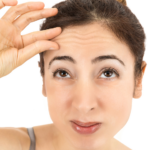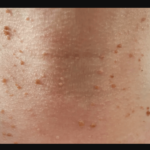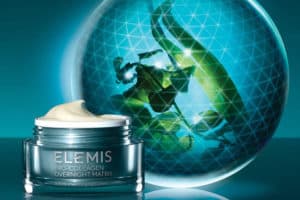Do you have wrinkles or creases across your neck and chest, or have you ever seen people who have beautiful complexions on their face but whose neck and chest looked about 10 years older?
If you’re wondering how to prevent wrinkles on neck and chest, follow these 8 tips:
- If You Have Poikiloderma of Civatte, Treat with Retinoids
- Avoid Extreme Changes in Weight
- Avoid Tech Neck
- Avoid Sleeping on Your Side
- Get Professional Skin Services
- Use Anti-Aging Products
- Cleanse and Moisturize
- Apply Product in Upward, Not Downward Motion
Read on to learn how to keep your neck and chest looking great for longer!
How to Prevent Wrinkles on Neck and Chest
1. If You Have Poikiloderma of Civatte, Treat with Retinoid or Hydroquinone
The skin on the neck and chest is very similar to the periocular area, which is the skin near the eyes. The thickness of the skin on the face is almost double compared to your neck and chest. This is why your neck, chest, and areas around the eyes show the first signs of aging.
This area gets just as much sun as your face does because of the thinness. It has fewer sebaceous glands and has thinner skin, so it tends to get drier. Some people may have more hair follicles in this area, so there’s also less structural support.
A lot of times, my clients have a skin condition called Poikiloderma of Civatte, and that’s basically a combination of hyperpigmentation, hypopigmentation, and underlying redness. It usually takes place in areas around the neck and sometimes on the chest.
For some reason, there’s no hyperpigmentation right underneath the chin, and that’s common. This is a sign of low estrogen levels as well as the effect of genetics which more women tend to have.
It can also be caused by wearing products that have synthetic fragrances. What happens is, when you’re exposed to the sun, the fragrance triggers the photosensitivity of the skin. That is called fragrance-induced hyperpigmentation. Obviously, more women tend to wear fragrance products.
If you look in the mirror and you see uneven skin tone whereby some areas are dark, some have no shading, splotches around your neck as well as your chest, and even some underlying redness, that’s usually what that is.
Sometimes, when that forms in women later in years, they might think that it’s just a birthmark that started to turn color. That’s actually Poikiloderma of Civatte.
No specific treatment exists for Poikiloderma of Civatte but some remedies that may help include hydroquinone, retinoids, and alpha-hydroxy acids. Remember to protect your skin from the sun, especially between 10 am and 3 pm, to prevent further damage.
2. Avoid Extreme Changes in Weight
Another factor that most people don’t consider is that if you have experienced sudden weight gain and weight loss or are going through repeated weight gain and weight loss throughout your life, it can affect the appearance of the skin on your chest and neck.
When you lose or gain weight, the skin on the neck and chest stretches and then shrinks back, so obviously, people who have lost a significant amount of weight will have loose sagging skin. By the time they’re a little bit older, they can have kind of that turkey neck.
3. Avoid Tech Neck
There’s another condition that has been coined, called tech neck. This happens when we are always looking at our phones, computers, laptops, or other gadgets.
To avoid tech neck, try to be more conscious when using your gadgets, and instead of looking down, you need to look at it at eye level. Adjust your laptop or your computer at eye level versus looking all the way down.
Along with tech neck, your chest can also be affected because when you’re looking down, you will start to slouch, creating creases on your chest. These are called cleavage wrinkles or langer’s lines. They are vertical lines that go straight down your chest.
4. Avoid Sleeping on Your Side
In relation to this, the second tip is that you should avoid sleeping on your side. When you sleep on your side, the skin creases tend to concave in through your chest and so try sleeping on your back. You can also put on a silicone-like gel on your chest to prevent the skin in between your cleavage from concaving. This flattens that out to prevent the breakdown of tissue in between.
5. Get Professional Skin Services
Our next tips involve treating your chest and your neck as if it was your face. A lot of times, people neglect their chest and their neck, and they just do their face. You have to continue it with your chest and the neck, and you can do that with services and/or products. These are all professional services, and I would recommend that you do them in wintertime.
For those of you who are not living in Southern California, where most of your days are cloudy and gray, this is actually an ideal time. It’s also colder, so you would be wearing sweaters and things that cover up your chest and your neck as it heals.
These services not only stimulate collagen production and elastin production but also have the side benefit of lightening and brightening your skin tone. I’m going to go from the least invasive to the most invasive one.
The first professional service is chemical peels. Since the area around your neck and chest is thinner and more sensitive, your esthetician or dermatologist is not going to leave the products on for long. They can tell you how many series you need based on what your skin looks like and the thickness of the skin.
Next, you can do microdermabrasion, and sometimes depending on the person who’s doing that, you can blend the two together. So you have chemical peels and microdermabrasion as well as micro-needling, platelet-rich plasma procedure, and laser, which is a medical procedure, so make sure you get a consultation before you do that.
You have to be an ideal candidate to get a laser done, and a lot of it depends on the condition of your skin based on the Fitzpatrick scale.
6. Use Anti-Aging Products
The next tip is basically about the products that you can use. You want to look for anti-aging products that are high in antioxidants, especially vitamin C and E, because they work together to increase their efficacy. In addition to antioxidants, you would want to look for anti-inflammatories to bring down the inflammation and the underlying redness that can cause hyperpigmentation.
Another one is the powerful peptides. Peptides are very targeted, and they actually have a time-release capsule, releasing the antioxidants exactly where they need to be and work in conjunction.
Next are retinoids and AHA’s or alpha hydroxy acids — the same as mentioned earlier to treat Poikiloderma of Civatte. You have to remember that you should never mix the ingredients because your neck and your chest are more sensitive than your face, and you might develop a rash by mixing the wrong ingredients.
7. Cleanse and Moisturize
Generally, you have to treat your neck and chest as if you are treating your face, so you would have to use a facial cleanser that’s pH balanced. You might also want to exfoliate your neck and chest, but because they’re more sensitive, stay away from granular scrubs and use something that’s more of an exfoliating powder as they are a little bit more gentle.
You can also use a serum, an antioxidant serum, or a hydrating serum. For creams, look for those that specifically are for the chest and the neck. Sometimes it’ll say neck and chest cream or neck and decollete cream, which are a little bit richer and have a thicker consistency.
During the day, you might not want to use a neck and decollete cream because it tends to be heavier and can get on your clothes. They also don’t have any sun protection, so we suggest you use the Lyra Clinical hydrating formula. It’s not just a basic sunscreen but actually has a high amount of antioxidants.
It is a mineral-based sunscreen and has no chemicals, so it doesn’t cause any inflammation or redness. It also has powerful stem cells for anti-aging, and the best one is, it has natural plant-based lighteners and brighteners. You can use this one on your neck and chest but make sure that you are not getting any redness, rashes, or flakiness on these areas.
8. Apply Product in Upward, Not Downward Motion
Here’s a pro tip. When you’re applying serums, lotions, creams, and sunscreens on your neck and chest, you never want to go down because gravity is constantly pulling down. You always start from the base. Lift your neck up and put the product on in upward strokes. The same thing applies to your chest. When you have wrinkles on your chest, they’re going down, so you want to work them up.
Same with when you’re applying lotion or products on your body, you also want to go from the base of your limb, whether it be your wrist or your ankles, and work your way up—none of the circular motions. Apply upwards.
Conclusion – How to Prevent Wrinkles on Neck and Chest
In summary, how to prevent wrinkles on neck and chest? Follow these 8 tips:
- If you have Poikiloderma of Civatte, Treat with Retinoids
- Avoid Extreme Changes in Weight
- Avoid Tech Neck
- Avoid Sleeping on Your Side
- Get Professional Skin Services
- Use Anti-Aging Products
- Cleanse and Moisturize
- Apply Product in Upward, Not Downward Motion
Related Questions
How to prevent wrinkles on neck and chest? In addition to what has been mentioned above, other tips include:
- Get enough sleep
- Minimize sun exposure
- Moisturize
- Avoid harsh soaps
- Wear the right-sized bra
- Apply products containing vitamin C
Can you use retinol on your neck and chest? The skin on the neck and chest is thin, so damage from the sun will be more visible, and it will be harder to treat. Some facial formulas with retinol, such as RoC Retinol Correxion Deep Wrinkle Serum, have been shown to be effective on the neck and chest, in addition to the face.
Can you use tretinoin on your neck and chest? Tretinoin can be used on the neck and chest, just as it is used on the face. Tretinoin is primarily used for the treatment of acne and is applied to the skin as a cream or ointment. It is also effective at improving the appearance of the neck and chest skin.

![Say Goodbye To Wrinkles On The Face [Easy Tips to Prevent Them] wrinkles on face](https://skincaregeeks.com/wp-content/uploads/2023/04/wrinkles-on-face-1-2-150x150.png)


![Read more about the article Radio Frequency Skin Tightening [Complete Guide]](https://skincaregeeks.com/wp-content/uploads/2020/02/radio-frequency-skin-tightening-300x200.jpg)

